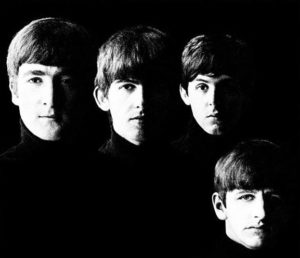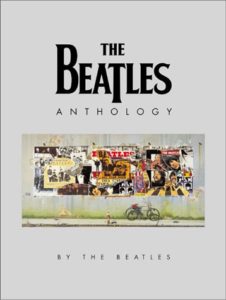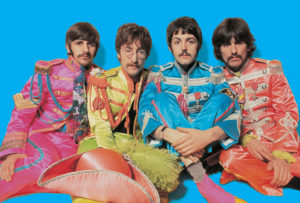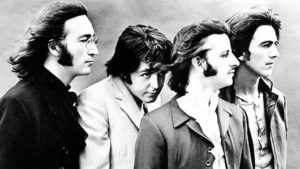Read the Beatles
Appeared in the Orlando Sentinel, October 2000
Nearly four decades after we were invited to Meet the Beatles, they’re back – and boy, do they have a lot to say.

The Fab Four began wrapping up their life stories five years ago with a multi-evening television event also called “The Beatles Anthology.” Along with the show came three double-disc sets, some “new” Beatles songs (the surviving three overdubbed on some John Lennon solo recordings), and the promise, someday, of a book.
So this is the book.
Coffee-table book with lots of pictures, right? The “perfect gift for the holiday season,” right? Same-old, same-old, right?
Not hardly. The five-year delay between this book and the television and CD versions of “The Beatles Anthology” was obviously because the Beatles had a lot to say.

The Beatles Anthology is an autobiography in four-part harmony. The late John Lennon’s comments are brilliantly chosen extracts from the many interviews he gave during his lifetime. (Always honest and unguarded, he seems to speak with remarkable insight you would think born of a 40-years-after-the-fact perspective. Yet footnotes identify the original dates of the quotes and they are often mere months after the events described.)
Paul McCartney, George Harrison and Ringo Starr have obviously spent the last several years being interviewed … and interviewed … and interviewed ….
This is “A Decade in the Life” and they leave very few moments of the 1960-1970 period unexamined. Each Beatle has a significant prologue about childhood and then the round-robin narrative takes off as they march through their history, adding color to stories we’re only heard in outline.
Lots of lunatics have written books about the Beatles and readers might think that they know the story. But really, only four people on earth knew what it was like to be a Beatle. And these four have enough integrity and courage to tell the story with all of its flaws clearly visible. The narrative structure allows for an odd sort of four-part dialogue (“I loved this song,” followed by “the middle part always bothered me.”). It helps make – for the first time – a full portrait of the Beatles.

It’s fascinating. The story is particularly illuminating in the last years, as the band heads toward the inevitable breakup. McCartney looks back and questions every move and wonders whether he was a bully to Harrison when he criticized his guitar playing. Harrison, then, wonders if he was being a petulant child and taking well-intended criticism as harshness.
At one point, describing the day he walked out on the group – a full year before the official breakup – Harrison interrupts himself to say, “It’s important to state that a lot of water has gone under the bridge and that as we talk now, everybody’s good friends and we have a better understanding of the past.”
Things were so bad in the last year, Harrison says, that guitarist Eric Clapton and pianist Billy Preston were invited to play on Beatles records so that the band members would be on their best behavior and not spend hours arguing.
It’s endearing also – considering all that the Beatles achieved – to hear them re-examine some of their career moves (the raw-meat-and-decapitated-dolls album cover, the “Magical Mystery Tour” TV film) and question their judgment. They did so much right, yet they sometimes still obsess over what little went wrong.
The book is most fun when they discuss the writing and recording of their brilliant songs. The Beatles were many things, but they were nearly always funny – so this book is a riot and hugely entertaining. There’s also some high drama as they describe the death threats and the Klan rallies that plagued them during their last concert tour in 1966.

Oh yes. There are a lot of pictures. You might have a shelf full of Beatle books and still you will be surprised by the pictures, and the other artifacts – letters, snatches of song lyrics, doodles.
There are a few other voices – producer George Martin, manager Brian Epstein, press agent Derek Taylor, road managers Neil Aspinall and Mal Evans – who contribute to the narrative. (Epstein, Taylor and Evans, all dead, made their contributions the Lennon way.) But as the story comes to a close one of the most important characters does not get to speak. It’s Yoko Ono.
Since the surviving Beatles still regard Yoko Ono as having played a role in ending the group, she needs to be heard. McCartney and Harrison speak of her with fondness and respect, yet still note her presence in the studio threw off the balance of the Fab Four. We want to hear from her but it looks as if 30 years after the breakup, the Beatles remain a boys club.
This is a thrilling book for anyone who cares about rock’n’roll. It’s also, obviously, a farewell from the three surviving Beatles. They have magnificently wrapped up their past and offered it up to their fans. They’re saying goodbye.
The book is much more than we expected – and we expected a lot. The ghost of John Lennon haunts the book and the last page of the book will give you a lump in your throat.
Trust us on this: a splendid time is guaranteed for all.
